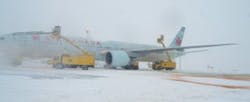In the Clutch
Through careful logging of daily deicing activity — including the amount of fluid dispensed and the number of aircraft deiced — the Servisair personnel at Toronto Pearson International Airport have kept a calculated eye to estimate the amount of fluid needed for impending inclement weather during the winter season.
But even the best laid plans have the potential to go awry — especially in the business of deicing aircraft at the world’s largest central deicing facility.
To provide assurance and limit rush orders, Dow Chemical Company, in its role as a glycol supplier to Servisair, has placed storage tanks on site for the deicing operator at its central deicing facility. The three poly tanks have a storage capacity of 25,000 liters (about 6,500 gallons) of fluid each. Under the agreement, the deicing facility is charged only for the amount of “emergency” stock that is used.
A model in cooperation
“The idea is in most situations they wouldn’t have to use it,” says Kendall Justiniano, market manager for the aircraft deicing group at Dow. “We could use our terminal deliveries. If we have enough lead time, we can almost always supply them what they need from our terminal and they have enough storage to be able to get through most events, but deicing is one of those things where it’s very much event driven so if you get into a situation and you have a significant storm, you could very quickly potentially max out and that’s the worry.”
The tanks were put on site in the 2006-2007 winter season. The program was spurred by Dow’s yearly analysis of its performance as a supplier, which indicated a notable number of rush orders for fluids at the Toronto facility. “Toronto is a real big station for us. We have a terminal position right outside the airport. We have the ability to get fluid there quickly so we were also wondering why the number of rush orders,” he says.
Dow engaged in discussions with Servisair to better understand the station’s operations, which eventually led to an agreement by both companies. “They were counting on us to be able to supply for them when they needed and they weren’t really considering the fact that if they can give us more lead time, we can actually respond in a better fashion,” Justiniano says.
“Once they realized that ... they were actually able to change their habits pretty easily and obviously they did that in exchange for us being able to position some of the material on site for them,” he says.
The extra on-site storage has acted as cushioning for the facility during order lead times. “That’s basically extra fluid in your back pocket,” says Graham Morgan, manager of operations for Servisair at the central deicing facility. “That will give me more time to estimate weather coming and the amount of aircraft that may be sprayed on a given event. That way I can order fluid from Dow approximately 24 hours in advance and still be comfortable that I have enough fluid on site.”
In the clutch
The facility, which has its own storage capacity of about 800,000 liters (roughly 210,000 gallons) of total fluid, found the on-site Dow tanks useful during what amounted to be a severe season. “This past winter we used those fluids many times,” Morgan says. “We had a horrendous winter this year.”
The unrelenting weather hit many stations. For the Toronto facility, it meant the deicing of more than 14,000 aircraft — a record high for the facility — and the dispensation of more than 10 million liters (about 2.6 million gallons) of total fluid, dwarfing an average of 7.1 million liters (about 1.8 million gallons).
The cost associated with keeping the additional fluid on site for emergency purposes has remained about even. “Essentially, we were able to reduce some of the cost that we had in extra tank shipments, rush-order shipments to them,” Justiniano says. “But we traded that off for some of the cost of keeping the tanks on site.
“But the real benefit to the program is that we’ve improved our on-time delivery which was good, it was already 95 percent plus, but I think last year and this year which has been an incredibly snowy season, our on-time delivery was 99 percent plus,” he says.
Dow has been in talks to possibly expand the program to additional locations. “It becomes dependant upon the specifics of the station. Toronto happens to use an awful lot of material,” Justiniano says. “But we’ve found some other places where this potentially might work and we are talking with customers about implementing it there as well.”
Justiniano says the program has exemplified a close working relationship between supplier and customer, which has allowed for operational advancement. “They’re very open with us, obviously, about how their operations work,” he says. “We’re very open with them about how we get fluids to them and in that dialogue, we find out things to be able to improve our service level and combine benefits to our customers.”
